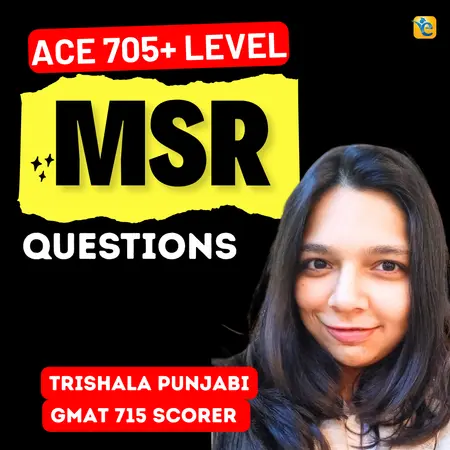Events & Promotions
|
|

GMAT Club Daily Prep
Thank you for using the timer - this advanced tool can estimate your performance and suggest more practice questions. We have subscribed you to Daily Prep Questions via email.
Customized
for You
Track
Your Progress
Practice
Pays
Not interested in getting valuable practice questions and articles delivered to your email? No problem, unsubscribe here.
- Nov 22
11:00 AM IST
-01:00 PM IST
Do RC/MSR passages scare you? e-GMAT is conducting a masterclass to help you learn – Learn effective reading strategies Tackle difficult RC & MSR with confidence Excel in timed test environment - Nov 23
11:00 AM IST
-01:00 PM IST
Attend this free GMAT Algebra Webinar and learn how to master the most challenging Inequalities and Absolute Value problems with ease. - Nov 25
10:00 AM EST
-11:00 AM EST
Prefer video-based learning? The Target Test Prep OnDemand course is a one-of-a-kind video masterclass featuring 400 hours of lecture-style teaching by Scott Woodbury-Stewart, founder of Target Test Prep and one of the most accomplished GMAT instructors.
Kudos
Bookmarks
alizainulabedeen
Statement 1 tells us that P(White AND Even) = 0
That is, there is no ball such that it is white and has an even number painted on it. Obviously, there could be balls that are white and there could be other balls with even numbers painted on them.
So P(White) or P(Even) is not given 0.
Kudos
Bookmarks
rjivani
What says that numbers are allotted in sequence? There could be 5 balls with number 1 on them, 10 balls with number 2 on them, 3 balls with number 3 on them and then rest of the 7 balls with numbers 4 to 10 on them. Or any other combination.
Kudos
Bookmarks
This is my approach. Please correct me where I went wrong.
I chose A for this one.....
- Label from 1 to 10 >> maximum number of each balls = 10
My curious is, from statement 1, can't we conclude that white balls are only marked with odd numbers?
Then, the total number of balls is 25 thus there are 5 white balls, 10 blue balls, and 10 red balls.
Blue balls and red balls have 5 even balls each. >>> Even balls = 10
White balls = 5
P(white)+P(Even) = 10/25+5/25 = 3/5
I chose A for this one.....
- Label from 1 to 10 >> maximum number of each balls = 10
My curious is, from statement 1, can't we conclude that white balls are only marked with odd numbers?
Then, the total number of balls is 25 thus there are 5 white balls, 10 blue balls, and 10 red balls.
Blue balls and red balls have 5 even balls each. >>> Even balls = 10
White balls = 5
P(white)+P(Even) = 10/25+5/25 = 3/5










